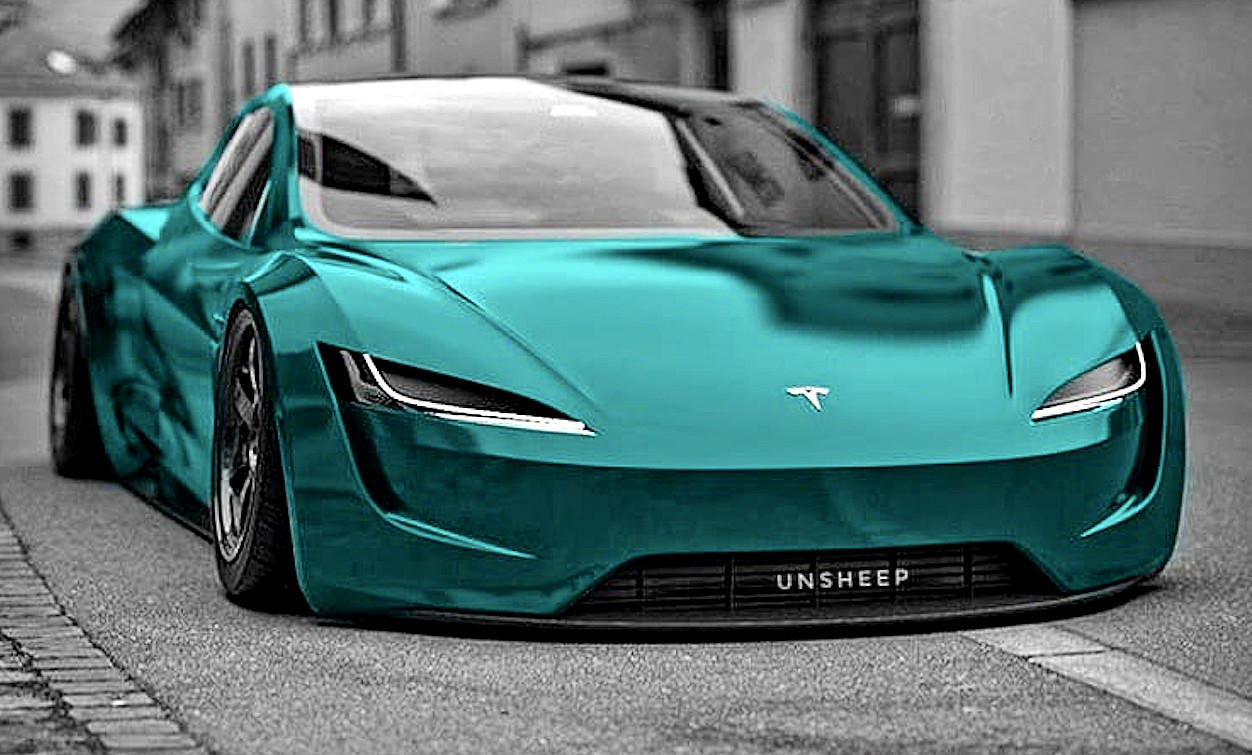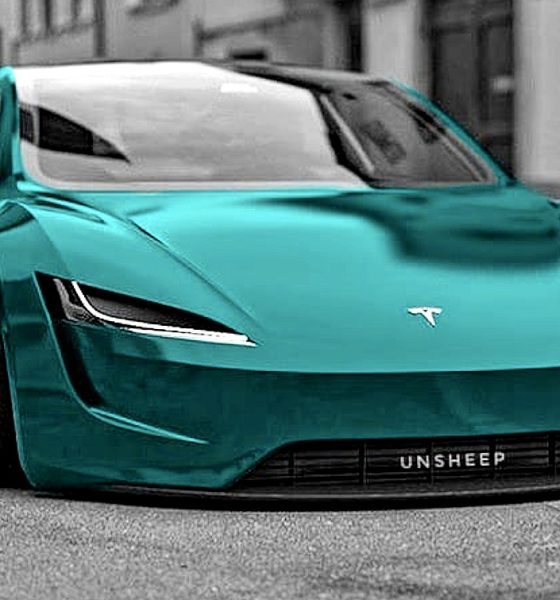

News
Tesla’s carbon-wrapped motor to pave way for new Roadster improvements
Tesla CEO Elon Musk appears to have shared one of the key updates that would be rolled out to the next-generation Roadster, an all-electric supercar that’s expected to be the company’s undisputed halo car. In a series of posts on Twitter, Musk explained that some of the Model S Plaid’s key innovations could pave the way for unlocking even more power for the next-generation Roadster.
Musk’s updates came as a response to Tesla bull @ajtourville, who inquired if the carbon fiber sleeves of the Model S Plaid’s rotors are direct-wound or pressed-on. The Tesla CEO noted that with the Model S Plaid, “fiber is wound over rotor at high tension load.” He also noted that the “carbon sleeve must put (the) copper rotor in compression or it loosens at low temp due to differential thermal expansion.”
Main advantage of this is a much stronger EM field compared with a rotor that is held together by metal (usually high strength steel).
Other advantage is that rotor can go to higher RPM, as carbon sleeve (mostly) stops copper rotor from expanding due to radial acceleration.
— Elon Musk (@elonmusk) June 13, 2021
Musk highlighted that Tesla’s carbon-coated motor has several key advantages, one of which is a stronger electromagnetic field compared to a rotor held together by metal such as high strength steel. The rotors can also go to a higher RPM, as the carbon sleeve mostly stops the copper from expanding due to radial acceleration. In a later tweet, Musk noted that these innovations had given Tesla some ideas for increasing the torque and maximum RPM of the next-generation Roadster.
This would make the all-electric supercar into something even more impressive than its prototype. When it was unveiled in late 2017, Elon Musk announced that the next-generation Roadster would have a wheel torque of 10,000 Nm, which is already very impressive in its own right. With a higher maximum RPM, the next-generation Roadster’s production could offer some monstrous amounts of power. Together with its SpaceX-infused tech and 620-mile range, the Roadster could truly stand above the Model S Plaid, effectively justifying its expected base price of $200,000.
The Plaid carbon-wrapped motor is arguably the most advanced motor on Earth outside of maybe a lab somewhere. We have to keep some secrets!
We have a few ideas for increasing torque & max rpm even further for new Roadster. Definitely fun & exciting engineering ahead!
— Elon Musk (@elonmusk) June 13, 2021
The machines that enable the production of the Model S Plaid’s new electric motors were made possible by Tesla Automation. Interestingly enough, Tesla Grohmann Automation, which is located in Germany, has been undergoing a pretty extensive expansion, as indicated by reports from electric vehicle owners in the area. This expansion is expected to correspond to more activity in the facility, particularly as Gigafactory Berlin starts its local operations.
The next-generation Roadster is the spiritual successor of the car that started it all for Tesla. But while the original Roadster was based on the Lotus Elise, the new Roadster is built and designed from the ground up by the company. This paves the way for specs that would likely need to be seen to be believed, such as its 0-60 mph acceleration of 1.1 seconds with its SpaceX package.
Do you have anything to share with the Teslarati Team? We’d love to hear from you, email us at tips@teslarati.com.

Elon Musk
Elon Musk confirms xAI’s purchase of five new 380 MW natural gas turbines
The deal, which was confirmed by Musk on X, highlights xAI’s effort to aggressively scale its operations.

xAI, Elon Musk’s artificial intelligence startup, has purchased five additional 380 MW natural gas turbines from South Korea’s Doosan Enerbility to power its growing supercomputer clusters.
The deal, which was confirmed by Musk on X, highlights xAI’s effort to aggressively scale its operations.
xAI’s turbine deal details
News of xAI’s new turbines was shared on social media platform X, with user @SemiAnalysis_ stating that the turbines were produced by South Korea’s Doosan Enerbility. As noted in an Asian Business Daily report, Doosan Enerbility announced last October that it signed a contract to supply two 380 MW gas turbines for a major U.S. tech company. Doosan later noted in December that it secured an order for three more 380 MW gas turbines.
As per the X user, the gas turbines would power an additional 600,000+ GB200 NVL72 equivalent size cluster. This should make xAI’s facilities among the largest in the world. In a reply, Elon Musk confirmed that xAI did purchase the turbines. “True,” Musk wrote in a post on X.
xAI’s ambitions
Recent reports have indicated that xAI closed an upsized $20 billion Series E funding round, exceeding the initial $15 billion target to fuel rapid infrastructure scaling and AI product development. The funding, as per the AI startup, “will accelerate our world-leading infrastructure buildout, enable the rapid development and deployment of transformative AI products.”
The company also teased the rollout of its upcoming frontier AI model. “Looking ahead, Grok 5 is currently in training, and we are focused on launching innovative new consumer and enterprise products that harness the power of Grok, Colossus, and 𝕏 to transform how we live, work, and play,” xAI wrote in a post on its website.
Elon Musk
Elon Musk’s xAI closes upsized $20B Series E funding round
xAI announced the investment round in a post on its official website.

xAI has closed an upsized $20 billion Series E funding round, exceeding the initial $15 billion target to fuel rapid infrastructure scaling and AI product development.
xAI announced the investment round in a post on its official website.
A $20 billion Series E round
As noted by the artificial intelligence startup in its post, the Series E funding round attracted a diverse group of investors, including Valor Equity Partners, Stepstone Group, Fidelity Management & Research Company, Qatar Investment Authority, MGX, and Baron Capital Group, among others.
Strategic partners NVIDIA and Cisco Investments also continued support for building the world’s largest GPU clusters.
As xAI stated, “This financing will accelerate our world-leading infrastructure buildout, enable the rapid development and deployment of transformative AI products reaching billions of users, and fuel groundbreaking research advancing xAI’s core mission: Understanding the Universe.”
xAI’s core mission
Th Series E funding builds on xAI’s previous rounds, powering Grok advancements and massive compute expansions like the Memphis supercluster. The upsized demand reflects growing recognition of xAI’s potential in frontier AI.
xAI also highlighted several of its breakthroughs in 2025, from the buildout of Colossus I and II, which ended with over 1 million H100 GPU equivalents, and the rollout of the Grok 4 Series, Grok Voice, and Grok Imagine, among others. The company also confirmed that work is already underway to train the flagship large language model’s next iteration, Grok 5.
“Looking ahead, Grok 5 is currently in training, and we are focused on launching innovative new consumer and enterprise products that harness the power of Grok, Colossus, and 𝕏 to transform how we live, work, and play,” xAI wrote.
Investor's Corner
Tesla gets price target bump, citing growing lead in self-driving

Tesla (NASDAQ: TSLA) stock received a price target update from Pierre Ferragu of Wall Street firm New Street Research, citing the company’s growing lead in self-driving and autonomy.
On Tuesday, Ferragu bumped his price target from $520 to $600, stating that the consensus from the Consumer Electronics Show in Las Vegas was that Tesla’s lead in autonomy has been sustained, is growing, and sits at a multiple-year lead over its competitors.
CES 2026 validates Tesla’s FSD strategy, but there’s a big lag for rivals: analyst
“The signal from Vegas is loud and clear,” the analyst writes. “The industry isn’t catching up to Tesla; it is actively validating Tesla’s strategy…just with a 12-year lag.”
The note shows that the company’s prowess in vehicle autonomy is being solidified by lagging competitors that claim to have the best method. The only problem is that Tesla’s Vision-based approach, which it adopted back in 2022 with the Model 3 and Model Y initially, has been proven to be more effective than competitors’ approach, which utilizes other technology, such as LiDAR and sensors.
Currently, Tesla shares are sitting at around $433, as the company’s stock price closed at $432.96 on Tuesday afternoon.
Ferragu’s consensus on Tesla shares echoes that of other Wall Street analysts who are bullish on the company’s stock and position within the AI, autonomy, and robotics sector.
Dan Ives of Wedbush wrote in a note in mid-December that he anticipates Tesla having a massive 2026, and could reach a $3 trillion valuation this year, especially with the “AI chapter” taking hold of the narrative at the company.
Ives also said that the big step in the right direction for Tesla will be initiating production of the Cybercab, as well as expanding on the Robotaxi program through the next 12 months:
“…as full-scale volume production begins with the autonomous and robotics roadmap…The company has started to test the all-important Cybercab in Austin over the past few weeks, which is an incremental step towards launching in 2026 with important volume production of Cybercabs starting in April/May, which remains the golden goose in unlocking TSLA’s AI valuation.”
Tesla analyst breaks down delivery report: ‘A step in the right direction’
Tesla has transitioned from an automaker to a full-fledged AI company, and its Robotaxi and Cybercab programs, fueled by the Full Self-Driving suite, are leading the charge moving forward. In 2026, there are major goals the company has outlined. The first is removing Safety Drivers from vehicles in Austin, Texas, one of the areas where it operates a ride-hailing service within the U.S.
Ultimately, Tesla will aim to launch a Level 5 autonomy suite to the public in the coming years.








